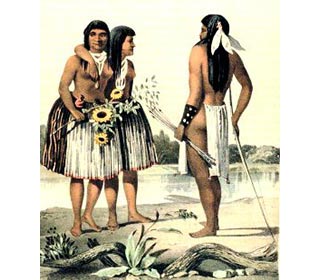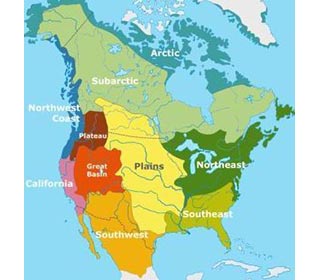What did the Yuma tribe live in?
The Yuma tribe lived in houses near the banks of the Colorado River. The rectangular huts were raised on stilts in order to protect from the seasonal flooding of the river. Their huts were similar to the brush shelter homes called wickiups that were used by other Native Indian tribes. A wickiup was a cone-shaped structure and made of a wooden frame covered with branches, leaves, and grass (brush). Their winter houses were wattle huts coated in mud, both inside and out. What language did the Yuma tribe speak?
The Yuma tribe spoke in the Yuman language. What did the Yuma tribe eat?
The food that the Yuma tribe ate included a variety of fish and shellfish including salmon, trout, eels, clams and crabs. Rabbits and fowl were in abundance in their area and were used as a meat supplement to their fish diet. They grew crops of beans, squash, corn (or maize), melons and pumpkins and the women collected roots, herbs and berries to add to their meals. What weapons did the Yuma tribe use?
The weapons used by the Yumas included spears, stone ball clubs, knives and the bow and arrow. Enemies captured during raids and battles were made slaves What clothes did the Yuma men wear?
The clothes worn by the men were limited to loin cloths woven from grass or bark fibers. Cloaks made from rabbit skins were worn if it grew cold at night. The Yumas were usually barefoot, but occasionally wore sandals. They adorned their hair with a pelican feather. What clothes did the Yuma women wear?
The type of clothes worn by the women were also limited. They wore willow-bark, knee-length skirts and, like the men, used rabbit skin cloaks at night. Both the men and women of the tribe wore jewelry made from shells and beadwork. They were highly skilled at creating beaded collars and necklaces with elaborate designs and patterns. What was the religion and beliefs of the Yuma tribe?
The religion and beliefs of the Yuma tribe was based on Animism that encompassed the spiritual or religious idea that the universe and all natural objects animals, plants, trees, rivers, mountains rocks etc have souls or spirits. The Yuma were a deeply religious people. Their supreme deity was Kukumat, who created the earth. His son, Kumastamxo took the people to the sacred mountain Avikwame and taught the people how to live, how to plant and and taught them how to cure illness. "Dreaming" was the source of religious power and the Yuma tribe underwent a form of a Vision Quest or Spiritual Journey which was sometimes accompanied by the inducement of a Trance State for the purpose of attaining guidance or knowledge from supernatural forces or spirits. The Yuma tribe also had a highly elaborate mourning ceremony. In order for the spirit of the deceased to enter the world of the Great Spirit, he had to be cremated. The life of the deceased person was honored during the cremation. All the possessions of the deceased were also burnt so that they might accompany the deceased into the land of the Great Spirit. The mourning ritual lasted for many hours, and when it was over, the deceased person was never spoken of again. Who were the most famous leaders and chiefs of the Yuma tribe?
The most famous leaders and chiefs of the Yuma tribe included Chief Pasqual. Yuma History: What happened to the Yuma tribe?
The Yuma tribe made first contact with the whites in 1540 when they were met by the Hernando de Alarcon expedition who was exploring the Baja California peninsula. The next recorded contact was in 1774 with the Spanish explorer Juan Bautista de Anza. At first the relationship between the Yuma tribe and the Spanish was cordial but in 1775 the tribe rebelled but were forced to submit to the rule of the Spanish. The United States acquired Yuma territory in 1853 with the Gadsden Purchase, which saw an influx of white settlers and farmers encroaching their lands and the Yuma War (1850–1853) erupted. The Yuma tribe then came into conflict with the Maricopas, and in 1857 the last major battle involving the Yuma was fought. Most of the defeated Yuma tribe were first forced to move to the Colorado River reservation that was established in 1865. In 1884, the Fort Yuma Indian Reservation was established, consisting of 45,000 acres in southeastern Imperial County, California and western Yuma County, Arizona. | 
